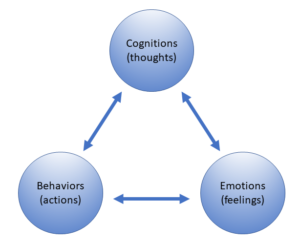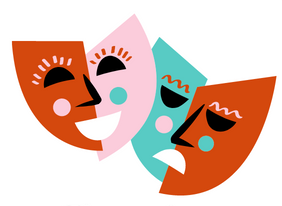Page Contents
What is Cognitive Behavioral Therapy?
Cognitive Behavioral Therapy (CBT) is psychotherapy for helping people get a handle on their problems. It is based on the fact that the interaction of thoughts, actions, and feelings drives our psychological state. In other words, our actions affect our thoughts and emotions, our emotions affect our thoughts and actions, and our thoughts affect our actions and emotions.

The Lingo: Cognition, Self Talk, Behavior, Action, Emotion, Feelings
Since I am going to talk to you about how to be your own CBT therapist, let’s first get you caught up on the lingo.
Cognitions = Thoughts = Self Talk = Internal Narrative = Personal Script = The Story You Tell Yourself
Behavior = Actions = Habits = The Things You Do
Emotions = Feelings
A Simple Example of CBT in Action
If you are about to give a speech to a large audience, you will feel nervous and uncomfortable if you think to yourself, “Yikes, they’re all staring at me. They must think I’m dopey.” As a result, your actions may be to speak too quickly, make poor eye contact with your audience, fiddle with stuff in your pockets, and so on. Consequently, you are likely to give a poor speech and quite possibly trigger the audience to think you are dopey. The applause will be half-hearted and you will end up feeling even worse.
 On the other hand, if you think, “Wow! All those people want to hear what I have to say,” chances are you will feel relaxed and in control. With this thought in mind, you are more likely to speak clearly, make direct eye contact, and smile. You may even find yourself strutting about the stage to emphasize your points. As a result, your speech is more likely to be engaging, and the audience will applaud whole-heartedly when you are done. You will come away from the experience feeling pretty good.
On the other hand, if you think, “Wow! All those people want to hear what I have to say,” chances are you will feel relaxed and in control. With this thought in mind, you are more likely to speak clearly, make direct eye contact, and smile. You may even find yourself strutting about the stage to emphasize your points. As a result, your speech is more likely to be engaging, and the audience will applaud whole-heartedly when you are done. You will come away from the experience feeling pretty good.
Easy, But Wrong, to Blame it All on Self Talk
From the above example, you might think that all you have to do is change your cognitions (thoughts) and life will be hunky-dory. And you would be right. But only sometimes!
The fact of the matter is that your actions can have an impact on your thoughts and emotions just as surely as your thoughts and emotions can affect your actions.
Back to feeling nervous about giving a speech, think about the difference in how you would feel if you took a deep breath, threw your shoulders back, lifted your chin and walked briskly onto the stage. Nervous or not, those actions typically linked to confidence can actually make you feel less nervous. Further, you will find it easier to think, “I have this!” as you hold you head high.
The Point of Cognitive Behavioral Therapy
 Cognitive Behavioral Therapy is about identifying the unique relationships between your actions, thoughts, and feelings. With this strategic approach, you figure out which patterns cause distress, and which work well for you. You learn to modify the patterns that interfere with your enjoyment of life and enhance those that improve your ability to live well and enjoy life.
Cognitive Behavioral Therapy is about identifying the unique relationships between your actions, thoughts, and feelings. With this strategic approach, you figure out which patterns cause distress, and which work well for you. You learn to modify the patterns that interfere with your enjoyment of life and enhance those that improve your ability to live well and enjoy life.
Change Your Story, Change Your Reality
The way you think about a situation is the story you tell yourself about it. That story has a powerful effect on how you feel about the situation. It also has a powerful effect on how difficult or easy it is to change your behavior.
For instance, I am writing this post on a Sunday morning while I await the arrival of my 7-year-old grand-daughter, Mellie, who asked for private time with me because “it’s not fair!” that her little brother who was ill last week was here without her. As I try to get as much of this post written before she arrives, how I feel about the time crunch can go one of two ways.
If I tell myself that I’m a foolish pushover who shouldn’t let others disrupt my plans, I will feel stupid and possibly a little resentful. Plus, it will be harder to write due to the distraction of my self-critical thoughts.
On the other hand, if I tell myself that I am lucky my grandchildren love to be with me, I will feel blessed and happily anticipate Mellie’s arrival. ♥ Feeling good about my relationship with my grandkids, it is easy to shift my attention back to this post and keep moving forward.
Notice that the same situation results in two very different emotional experiences depending on the story I tell myself about it. And that, in turn, affects my ability to write (action).
What Does a Cognitive Behavioral Therapist Do?
The best explanation for what I do as a CBT psychologist was one I came up with at a party many years ago. My husband and I were at a lovely gathering at the home of a neighbor. My husband is an engineer, I’m a psychologist, and everyone else at the party was in the theater world. Trust me, everyone else at this party was much more interesting than either my husband or me.
At one point during the evening I was cornered by a theater person who asked, “What exactly IS therapy? What do you DO?” (And I suspect she really meant, “Do you do anything useful or interesting?”)
Hmm…how to explain. 
I could launch into a riveting monologue about the role of classical and operant conditioning in shaping cognitive distortions and the strategies to identify and reframe …. not sure that would snag me an invite to the next party. Instead, I explained it as follows.
I am an Assistant Script Editor.
My job is to help patients identify their personal scripts, the stories they tell themselves about their situations. I then help them edit those scripts to shift their perspective and ultimately shift their life experience.
How to Be Your Own Cognitive Behavioral Therapist
Whether you are fighting depression and anxiety or struggling with unhealthy habits, self-change begins with self-awareness. And that requires you pay attention to your thoughts, feelings, and actions—but in a different way than we normally do when we notice ourselves feeling happy or sad.
To get a handle on the patterns that have power over you, keep a log of your experiences. In a notebook or on your smartphone or computer, record the date and context of the problem you are trying to address. As you grow this log, do three things:
- Look for common situations that trigger the problematic response.
- Dig deep to identify the story you are telling yourself about the situations.
- Edit that story to tell a more health-promoting message.
As an example, consider Aida, a patient whose struggle with binge eating disorder I describe in A Diet is the Last Thing You Need.
Look for Common Situations that Trigger the Problem
Aida had a stressful job that left her fried by day’s end. She also had binge eating disorder and suffered with obesity and its resulting physical problems. Despite promising herself every morning that she would not binge that evening, five o’clock found her leaving work, swinging by the grocery store to load up her cart, and heading home where she would spend the next two-plus hours eating. This happened at least three days each week, not always on the same day of the week.
By keeping a daily log of her thoughts and actions as she left work and through the evening, she was soon able to discern a pattern. Here’s what her log looked like.
| Day | Binge? | Thoughts/Feelings |
| Monday | No | Work was wild but I did prevent some disasters. Go me! |
| Tuesday | Yes | Crappy day. No one appreciates how much trouble-shooting I do. I am so stressed I can barely stand to be in my skin. I need to escape this feeling.
After binge: I can’t believe I did it again. I’m hopeless. I don’t even deserve to be healthy. |
| Wednesday | Yes | Who am I kidding. I’m hopeless. I can’t stand feeling this way.
After binge: Hopeless idiot, that’s me. |
| Thursday | Yes | What’s the point.
After binge: |
| Friday | No | Even though my boss doesn’t seem to know how to compliment good work, I know I did good work. Glad it’s Friday. I earned a relaxing weekend. Going to schedule a massage for tomorrow! |
| Saturday | No | |
| Sunday | No |
Identify the Story You are Telling Yourself
Reviewing her log, Aida noticed a few things about her self-talk and her behavior.
- She felt good and did not binge when she acknowledged her successes—even though her boss clearly was a lousy manager!
- She told herself that she could not tolerate the stressful feelings.
- The more negatively she spoke about herself, the more she gave up on even trying to manage her behavior. By Thursday, she didn’t even bother making a note after the binge.
Edit the Story
The first thing Aida did was grapple with how much power she was giving her (lousy) boss over her emotional state and behavior. She was a competent individual who knew how to do her job and did it well. The fact that her boss was too ignorant about management to recognize the need for positive feedback did not mean Aida did not deserve positive feedback. So she decided that giving herself a pat on the back every day was a good way to take ownership of her power, and lessen the intensity and frequency of stressful feelings.
The next storyline that Aida tackled was the one about how she could not tolerate those stressful feelings. Telling herself “I have to escape this feeling” makes it impossible to focus on tolerating the feeling until it passes. To help herself tolerate the urges to escape/binge without acting on them, she used the Grand Canyon metaphor I talk about in the book and edited the self-talk accordingly.
Finally, she saw the accumulating behavioral impact of her negative self-talk. Despite her motivation to get a handle on this problem and her commitment to logging, as the week wore on, her notes became more sparse. Seeing this as a signal that she was giving up, even though she did not articulate that sentiment to herself, Aida scripted new self-talk to address that.
This was her log several weeks down the road:
| Day | Binge? | Thoughts/Feelings |
| Monday | No | Work was s**t as usual but as usual I put out the fires before they spread. |
| Tuesday | No | Crappy day but I managed it as well as could be expected even though my boss is allergic to acknowledging that. |
| Wednesday | No | I am so stressed I feel like I’m going to fall into a bottomless dark abyss if I don’t escape this feeling. But! I know that if I wait it out, distract/relax for a bit, the feeling will pass and I will be much happier in a few hours than if I give in to the urge to binge.
Later that evening: Go me! It felt like I’d lose my mind but I didn’t. I am a rock star! |
| Thursday | Yes | Worst day ever—I really need to escape.
After binge: I feel terrible and really don’t want to record this. But I know this is the way to get better. I slipped today but I know what to do to make myself stronger. I think it will help if I write some positive self-talk on index cards to keep in my car for when I leave the office in distress. |
| Friday | No | Another insane day, hard to remember what I’m trying to accomplish. The index cards I left on the driver’s seat this morning did the trick! |
| Saturday | No | |
| Sunday | No |
When the Problem is Too Big
When you find yourself continuing to struggle with a problem despite your best efforts at self-help, it is best to seek help from others. Sometimes, talking it through with a trusted friend or family member is all it takes.
Sometimes you decide you need help from someone trained to help you sort through the mess. When that is the case, congratulate yourself on being smart enough to figure it out and reach out. Here are some sites that can help you find a therapist that matches your needs:
Psychology Today Therapist Finder
Find a CBT Therapist Directory
Academy of Eating Disorders Expert Directory Search
American Psychological Association Psychologist Locator
National Register of Health Service Psychologists Find a Psychologist
What Mellie Knows
During first grade, Mellie brought home an assignment for which she had written her name in the center of a flower and on each petal wrote something that made her happy. There were five petals. Mellie’s valued items were,” family, unicorns, friends, rainbows, and treat.”
The lovely flower was given a prominent place on my fridge and she was very proud. A few minutes after it was hung, she wandered back to admire at it again. Never missing a chance to reinforce emerging reading skills, I asked her to again read the petals to me. Mellie carefully articulated each word but when she got to “treat,” exclaimed, “Oh no!” Emphasizing the “s,” she explained “I want treats!”
Mellie got a pencil, took down the picture, and added the “s.” Words have power!


I found this article to be a valuable resource for anyone seeking to understand the inner workings of this widely-used therapeutic approach. Thank you for providing such valuable information and shedding light on the effectiveness of cognitive-behavioral therapy.